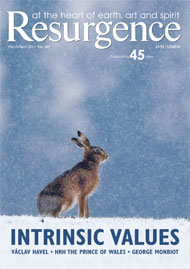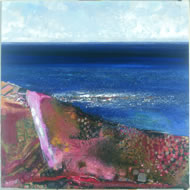Twelve essayists – amongst them a poet, novelists, art historians and Nature writers – have created here an intricately rich portrait of the Cornish-based land and seascape painter Kurt Jackson (b. 1961). The son of two abstract painters, Jackson grew up surrounded by paintings. He tells Howard Jacobson that, as a boy, he “came home from school, got into rough clothes and went looking in hedgerows, turning over stones, looking at birds”.
After studying zoology at Oxford University, he and fellow zoology student Caroline trekked around Africa for a year, before settling, marrying and having children in Cornwall. Without any formal art education, Jackson started painting there with the kind of authentic passionate focus he has sustained ever since.
Mike Tooby writes: “Jackson came to live in Cornwall in 1984. He spent five years in the place he first chose, Boscastle in North Cornwall, before moving to Penwith, also loosely referred to as West Cornwall. By settling above Botallack, he lives a long way from [the artistic communities of] St Ives and Newlyn. The central points of his locality are St Just and [a] straggle of former mining villages.”
John Russell Taylor points out that Jackson is a traditional painter in the sense that “you cannot see any of his paintings…without being aware of a great underlying body of tradition” that includes, for example, “Turner’s later, more abstracted works” and “Constable’s more private watercolour sketches”.
The wildly sensitive, spontaneous mark-making that pervades Jackson’s art, while inseparable from a real, sensuous observation of Nature, has affinities with paintings by American Abstract Expressionists, the intuitive expressionism of Joan Eardley’s 1950s’ and early 1960s’ Scottish seascapes and landscapes, and works by the contemporary German painter Anselm Kiefer.
For example, Kiefer has extensively incorporated pieces of glass, straw, wood and plants into landscapes charged with dark historical resonances. Jackson started out melding sand and small pebbles into the paint surface but now opts for radically exploratory effects.
Mark Cocker describes him incising “with a razor blade a bruised grey sky he has just laid on the paper”, and how “at one point…he uses all the digits from both hands and it looks as if he is playing the piano in his own wet paint”.
Frequently, words are scrawled onto the paint – such as “the sun breaks through and the kittiwakes start to scream”. The overall result is that the viewer is absorbed, with an awestruck force, in Nature’s infinitely subtle and diverse atmospheres and rhythms.
Jackson draws and sketches prolifically en plein air, making paintings later on in the studio based on diverse, accumulated studies. He is a real visionary explorer; canoeing, wading and swimming in many rivers, and traversing the Penwith moors with their megalithic burial mounds and stone circles. He is enmeshed in English woodland thickets, scorched in ancient Greek olive groves. Jacobson writes: “The amazing thing to me is that out of his weather-beaten artisanal bulk should come work of such exquisite sensuousness.” Richard Mabey notes: “What is impressive is his painterly translation of the ecology of wild places.”
Terre d’Oliviers, big buzzy flies and hot happy grasshoppers within the shade of this olive tree is the informally inscribed title of a 2003 painting. Bel Mooney writes: “the olive groves of Kardamili represent an ancient transaction between humans, culture and the land. There has been a settlement in this region since the…time of Homer.” Jackson’s black olive trunks and branches are numinous, monumental presences, yet they seem to dance like some archaic, stalwart calligraphy across the earth shimmering pink and gold with parched grasses.
Jackson’s painting of the A3071, dusk. Car lights from/into St Just, last night of the Millennium, reveals a both matter-of-fact and apocalyptic journey. It shows a patch of egg-yolk brilliancy glowing on the grey tarmac, itself glistening a delicious pink colour, partly reflected from an intense sunset red permeating the roadside. Beyond are stretches of interminable blackness. The Millennium reference is both starkly descriptive (as in a neat diary entry) but also, subtly, symbolically evocative of the bright hopes and aspirations, bloody possibilities and broodingly dark mystery evident at the end of one great historical era, and the beginning of a fresh one.








